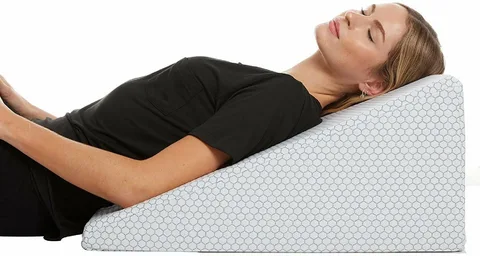A clean pillow equals a peaceful night’s sleep. However, when it comes to specialty bedding like a wedge pillow, many overlook the most important component: its cover. While the wedge pillow itself supports your back, shoulders, and sleep quality, the cover for a wedge pillow ensures hygiene, comfort, and longevity.
Over time, dirt, sweat, and bacteria can build up on the surface, which not only affects the look but also impacts your health. So, how do you make sure your pillow stays fresh, functional, and inviting?
This blog walks you through everything you need to know—from cleaning routines to choosing the right materials. Whether you’re a first-time buyer or someone who already owns a wedge pillow, this guide will help you take better care of your investment.
Why the Cover Matters?
It’s easy to assume the core pillow is what matters most. But the cover does the heavy lifting in daily wear and tear. A good cover protects the pillow from moisture, oils, and allergens. This barrier prevents deep stains and bacterial growth, keeping the pillow fresh for years.
Experts in sleep ergonomics often stress that surface cleanliness is crucial for skin health and respiratory wellness. According to the American Academy of Dermatology, unwashed bedding is a leading cause of acne and allergic reactions. Regularly washing your wedge pillow cover can significantly reduce these risks.
Know Your Fabric
Different covers use different materials. And each one comes with its own cleaning requirements. Choosing the right cover for a wedge pillow involves not just texture preference but also ease of care.
Here’s a comparison table of common fabrics and their maintenance requirements:
| Fabric Type | Feel | Machine Washable | Drying Method | Durability |
| Cotton-Poly Blend | Soft and durable | Yes | Air dry recommended | High |
| Bamboo Rayon | Silky and breathable | Yes | Low tumble dry | Medium-High |
| Microfiber | Smooth and lightweight | Yes | Machine dry | Medium |
| Organic Cotton | Natural and crisp | Yes | Air dry recommended | High |
| Velvet/Plush | Luxurious and warm | No | Spot clean only | Medium |
Understanding this helps you manage your cover better. For instance, if you’re someone who sweats at night or has sensitive skin, a bamboo or cotton-poly blend cover will likely serve you best.
As a general rule, wash the cover at least once a week. However, this can change based on climate, skin conditions, and usage. During hot summers, you may need to wash it more frequently.
Here’s a quick reference guide:
| Usage Frequency | Wash Frequency |
| Daily use | Once per week |
| Alternate nights | Every 10-14 days |
| Post-surgery/recovery use | Twice per week |
| Pet exposure | Twice per week |
If you have two covers, rotate them. This not only extends their lifespan but also ensures that one is always clean and ready to use.
Step-by-Step Cleaning Process
Keeping your cover in good shape isn’t difficult, but a few smart tips can make it last longer and look newer.
- Read the label: It might sound basic, but skipping this can damage the fabric. Always check whether the fabric needs cold water, delicate cycles, or air drying.
- Pre-treat stains: Sweat marks or accidental spills? Use a mild, non-bleach stain remover. Let it sit for 10 minutes before tossing it into the wash.
- Wash with similar fabrics: Avoid washing with jeans or towels. These rough fabrics can pill or stretch the cover’s surface.
- Avoid hot water: High temperatures can shrink or damage elastic fibers in the cover. Stick to cold or warm water settings.
- Air drying, if possible: Machine drying might be faster, but air drying prevents shrinkage and fabric stress.
Dealing with Common Problems
Some issues are common when cleaning or maintaining the cover.
Here’s how to address them:
| Problem | Solution |
| Shrinking after wash | Use cold water and avoid high-heat drying. |
| Stubborn odors | Add half cup of white vinegar to the rinse cycle. |
| Fabric pilling | Wash inside out; avoid rough-textured items in the load. |
| Colour fading | Wash with like colors and use a mild detergent. |
| Hard-to-remove stains | Soak in warm water with baking soda for 1–2 hours. |
If you experience frequent fabric issues, it may be time to consider changing your cover material or trying a new brand.
Should You Replace Your Cover?
Even the best-maintained cover has a shelf life. Fading, thinning fabric, or persistent stains that don’t come out are all signs that you should consider replacing it. On average, a high-quality cover should last about 12 to 18 months with regular use and proper care.
Recent surveys show that 72% of consumers using wedge pillows prefer to purchase an extra cover upfront. This allows for smoother laundry cycles and keeps the pillow in use without interruptions.
What Makes a Good Replacement Cover?
When buying a new cover, don’t just focus on the color.
Consider the following:
- Compatibility with your pillow size and shape
- Fabric type and washability
- Zip quality or closure method
- Skin-friendliness (especially if you have eczema or allergies)
- Brand support (availability of instructional videos or replacement policies)
If you’re unsure about the size, always check the brand’s fit guide or contact customer support. Buying the wrong size is a very common mistake, and a poor fit can affect both comfort and protection.
Final Thoughts
A clean and well-maintained cover for a wedge pillow plays a big role in your overall sleep hygiene and comfort. It’s not just about aesthetics—it’s about health, durability, and peace of mind. When you invest in caring for your pillow cover, you’re investing in better rest and a healthier lifestyle.
It doesn’t take much—just a little consistency, the right tools, and the right know-how. With the right cleaning habits, your pillow stays fresher, looks better, and lasts longer. After all, small steps often make the biggest difference when it comes to wellness and comfort.















